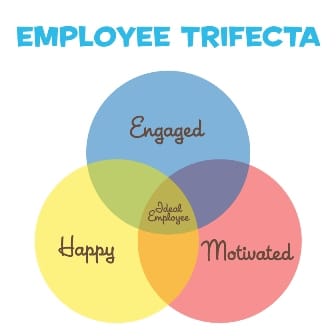Happy Employees are not Engaged Employees
(Editor’s Note: Today’s post is sponsored by SilkRoad technology, a leading provider of cloud-based social talent management solutions that develop engaged employees who drive exceptional business performance and agility. Creating a world-class employee experience is SilkRoad’s passion and drives everything they do.)
Ultimately, we want happy, motivated employees who are also engaged. The trifecta of employee success. So, the question becomes – how do we make that happen?
In just a few weeks, I will be speaking about employee engagement at SilkRoad technology’s annual users conference. I’m on a panel with fellow HR bloggers Alexandra Levit and Lisa Rosendahl to discuss the trends and share critical insights.
With the event coming up, I’ve been doing my research and thinking a lot about the subject. Employee engagement is a hot topic. It made me focus on the true meaning of employee engagement. I sometimes wonder if engagement has turned into this catch-all term for everything that has to do with employees.
You know me, when in doubt…pull out the dictionary. Or in this case, Wikipedia:
Employee satisfaction deals with happiness. Are employees happy at work? Simple enough.
Employee motivation is about getting something. Does an employee receive those things they are looking for at work in return for their efforts on the job?
Employee engagement is a little different. It’s about connecting with the company. Because when employees are connected, they understand what it takes for the company to be successful, want to see the organization succeed and are willing to do what it takes to help the business get there. That’s a very important distinction.
So, it’s very possible that an employee can be happy and not connected to the organization. The employee who comes in, does their job and goes home. They love it when no one bothers them. And, they will tell you so. “Just let me come and in do my job. Don’t make me talk to anyone.” Happy – yes. Engaged – no.
And then there are those employees who are insanely motivated. Motivated by money, motivated by an employee perk or benefit, possibly even motivated to take on new roles and responsibilities so they can eventually get promoted. They are motivated by what they want not necessarily what’s best for the company.
In both cases, these employees can be excellent performers. It’s not to say they’re doing anything wrong. They are delivering what the company asks of them. But they aren’t engaged. An engaged employee is going to work toward moving the business to the next level.
Ultimately, we want happy, motivated employees who are also engaged. The trifecta of employee success. So, the question becomes – how do we make that happen?
The first thing we need to do is let employees own their career. It’s their professional life and they deserve to have control over it. It also means our role as managers and leaders has to be one of a facilitator versus director.
Managers wanting to incorporate facilitation into their relationships should focus on two skills:
Process development – Good facilitators can walk thru a logical, well thought out process.
Just because an employee is in control of their career, doesn’t mean they won’t need help or guidance along the way. Managers have a great opportunity to help their employees reach decisions by asking questions and walking them through a process. Instead of telling someone what to do…employees are able to figure it out on their own. (Well, at least with a little help.)
Neutral positioning – A facilitator is non-judgmental and respectful of others. Their role is not to provide an opinion but to draw information out of others.
Every employee has their own career goals. Some people might think they are awesome. Others might feel they are worthless. If a manager weighs in on an employee’s career aspirations and either criticizes them or is wrong about them…it will damage their working relationship with that employee.
This doesn’t mean that as facilitators we aren’t allowed to share information. In fact, being able to convey experiences and expertise will only empower employees more when it comes to taking responsibility for one’s career decisions. The key is to use those moments as two-way conversations not one-way instructions.
I’m interested in hearing your thoughts about employee engagement. What does it mean in your organization? And how can we get employees more engaged with our businesses?
5